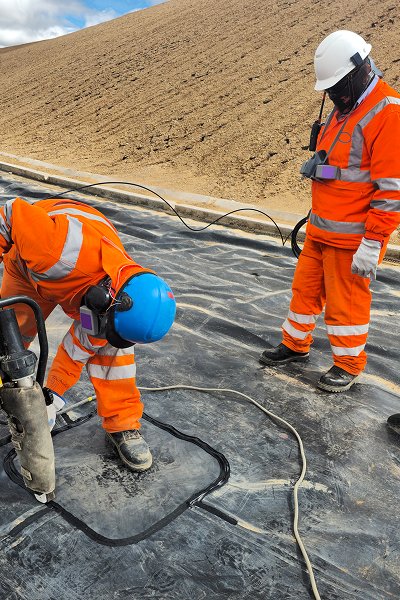Why do prices for non-woven geotextiles vary so widely?
Products labeled "non-woven geotextiles" on the market can have unit prices ranging from 1.8 yuan to 16 yuan per square meter, a price difference of more than eight times. This significant discrepancy isn't due to "manufacturer price gouging," but rather to the following key variables that directly impact cost and performance:
① Raw Materials: Recycled vs. virgin materials offer significant differences.
Nonwoven fabrics made from 100% recycled materials can directly reduce prices by 30–50%.
Fabrics made from virgin PP/PET have vastly different mechanical properties, durability, and aging resistance.
→ For a 300g/m² product, recycled fabric might cost 2.8 yuan, while virgin fabric might cost 5.5 yuan.
② Processing: Staple Needle Punch vs. Polyester Filament Hot Rolling
Staple Needle Punch: Inexpensive, suitable for general projects.
PET Filament Hot Rolling: High strength, long life, but 30–80% higher cost. Although both are "nonwoven geotextiles," the pricing logic for these processes differs.
③ Performance Levels: Looking beyond weight alone.
Many people simply ask "weight," but the true performance determinant isn't weight, but strength parameters:
Tensile Strength (kN/m)
CBR Bursting strength
Puncture resistance and aging resistance
Engineering only specifies weight requirements without specifying performance indicators. This allows prices to be kept very low—but quality is uncontrollable.

What are the basic cost components of geotextiles?
Raw material cost - the core factor determining the cost (accounting for 50%-75%)
Raw material type: PP (polypropylene) / PET (polyester)
Raw material grade: virgin vs. recycled
Are anti-aging additives or UV stabilizers added?
Processing and auxiliary costs (5%-10%)
Roll cutting, rewinding, and width-setting
Packaging materials (strap tape, film, pallets)
Quality inspection and equipment maintenance costs
Workshop labor and waste
5 major factors affecting the price of non-woven geotextiles
Weight and Thickness (The Most Intuitive Factor)
Non-woven geotextiles are often quoted in yuan/㎡, with the higher the grammage (g/m²), the higher the cost.
However, be aware that the same grammage does not necessarily mean the same performance. If the density is insufficient or the fibers are loose, a low-priced fabric may be heavier but have poor performance.
Raw Material System (Virgin vs. Recycled Material Makes a Huge Difference)
Virgin PP/PET – High strength, aging resistance, good stability, and high price
Recycled – 30–50% cheaper, but with significantly reduced durability and strength
Manufacturing Process & Technical Grade
The manufacturing technology used in nonwoven geotextiles is a major driver of cost variance.
Although all of them are “nonwoven fabrics”, the internal structure and mechanical performance differ substantially depending on the process.
Common processes include:
| Process Type | Description | Cost Level |
|---|---|---|
| Needle-punched short-fiber nonwoven | Mechanically entangled PP/PET staple fibers by repetitive needle punching. Common for road and landscaping projects. | Low–Medium |
| Continuous filament (PET) nonwoven | Formed by continuous polyester filaments bonded by needle-punching or thermal bonding. Higher strength and durability. | Medium–High |
| Composite nonwoven (e.g. with geomembrane or geonet) | Multi-layer structure achieved by lamination or bonding for enhanced filtration or reinforcement. | High |
Standards Implementation and Certification Requirements
Is the product manufactured in accordance with GB standards?
Does it meet ASTM/EN project requirements?
Is SGS/Intertek/CMA testing required?
Are warranties, CE certification, or third-party certification reports provided?
Order Terms and Delivery Method
Price depends not only on the fabric itself but also on the commercial terms:
Order quantity (small orders cost more)
Roll width/length (custom orders incur additional processing costs)
Delivery method: Ex-factory/Ex-factory (tax included)/Delivery to construction site/Export FOB/CIF
Credit terms and payment terms (cash vs. credit)
Payment requirements (pallet/waterproof film/wooden crate)
How can I tell if a nonwoven geotextile quote is reliable?
Weight (g/m²)
Material (PP/PET, virgin/recycled material ratio)
Processing (needle punching/hot rolling/compounding)
Standards (GB/ASTM/EN)
Functional specifications (tensile strength, CBR bursting strength, etc.)
Delivery terms (tax included/tax excluded/to factory/to construction site/FOB/CIF)
Non-woven geotextiles are the most widely used and versatile foundational material in geosynthetics. The significant price differences in the market aren't simply a matter of selling the same thing in different ways. Instead, they're driven by a host of underlying variables, including material source, process path, performance requirements, order model, and supply chain configuration. Understanding these variables is crucial for assessing the reliability of quotes, selecting the right supplier, and making sound purchasing decisions.


